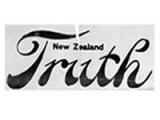What happened that day?
See historic events for any day of the year by entering the date below. Why not try your birthday?
Kiwi of the Week
Today in History

1905 New Zealand Truth hits the newstands
At its peak in the 1950s and 1960s, New Zealand Truth prided itself on being ‘the champion of the little person and the scourge of corruption and scandal in high places’.
The weekly newspaper was founded by Australian John Norton, who modelled it on similarly populist papers across the Tasman. A colourful character, Norton was an alcoholic megalomaniac obsessed with Napoleon and Julius Caesar. In its first decades Truth described itself as ‘The People’s Paper’, and until the 1920s it took a markedly left-wing stance on many issues. It regularly attacked ‘wowsers’ (a word invented, or at least popularised, by Norton in Australia around 1900), fat-cat businessmen, hypocritical politicians and faith healers. By 1928, it was selling almost 100,000 copies each week.
According to historian Redmer Yska, in the mid-20th century Truth ‘became the voice of the “ordinary New Zealander”. By the 1950s, one in two New Zealand households bought it. Respectable readers always claimed an interest in the recipes and racing pages − never the spicy scandals and divorces.’ Although the paper relied on crime and deviance for much of its news, it also had a deep concern for conformity, morality and law and order.
In the 1960s and 70s Truth became increasingly conservative, railing against ‘Reds under the bed’, Pommy unionists, bludgers and long-haired students. By the time its office moved from Wellington to Auckland in the early 1980s, both the paper’s readership and its influence were on the wane.




















